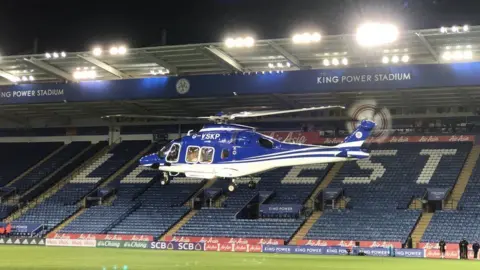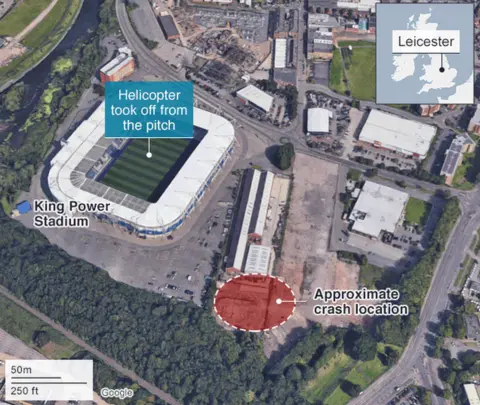 Getty Images/Facebook/Instagram
Getty Images/Facebook/InstagramAn inspector who investigated the fatal helicopter crash outside Leicester City’s stadium in 2018 said delays from the Covid pandemic was one factor that led to a final report being published almost five years later.
The inquest, which began on 13 January, is looking into the deaths of Foxes chairman Vichai Srivaddhanaprabha, fellow passengers Kaveporn Punpare and Nusara Suknamai, pilot Eric Swaffer and his partner Izabela Roza Lechowicz.
Mark Jarvis, principal inspector for the Air Accidents Investigation Branch (AAIB), has been giving evidence to the inquest at Leicester City Hall on Monday.
Mr Jarvis previously told the inquest his conclusions of how the tail rotor duplex bearing failed and caused the helicopter to enter an uncontrolled spin on 27 October 2018.
On Monday, Mr Jarvis talked the jury through the various safety recommendations given to the European Union Aviation Safety Agency (EASA), made by the AAIB in its final report, published in September 2023.
He also gave a timeline of the final report’s creation.
The AAIB provided initial findings in the form of special bulletins to the wider aviation community soon after the crash, Mr Jarvis said.
In late 2020, a new design of the duplex bearing was introduced, he added.
 Pete White
Pete WhiteMr Jarvis explained the pandemic caused “significant delays” of the transportation of components needed for investigations.
He told the inquest that staff across Europe were not available and laboratories were closed.
“We were delayed in terms of how quickly we could get results,” Mr Jarvis said.
The first draft of the AAIB’s final report was shared to all concerned parties in November 2020.
Mr Jarvis said the branch was provided with new evidence during the consultation process that “required us to go through new analysis”.

The ANSV, the Italian air accidents investigation authority, responded to the report with “new and significant information”, Mr Jarvis told the jury.
He said new tests and analysis were then carried out by the AAIB, which involved “a huge amount” of additional work.
Another final draft was produced in March 2023, which the ANSV responded to by letter, raising other possibilities for the bearing seizure.
The final AAIB report was published in September 2023, finding the crash was “inevitable” after a sequence of mechanical failures, and said the pilot could have done “very little” to save everyone on board.
The ANSV’s letter was included in the final report.
It did not dispute that the seizure did cause the accident, nor did it dispute that the pilot was not at fault, Mr Jarvis added.
“It is the longest investigation I have been involved in,” Mr Jarvis added.

Leave a Reply